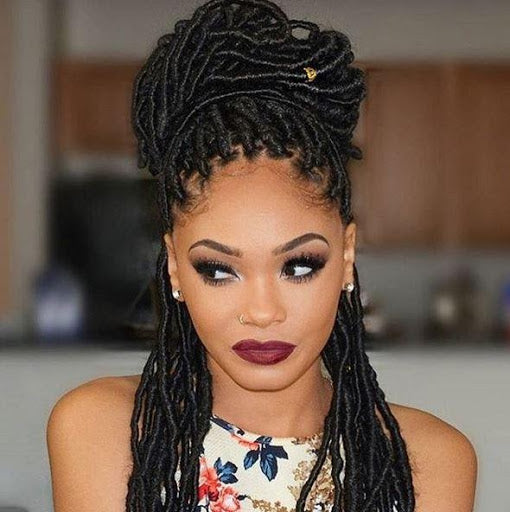
Protective Styles for Fall & Winter

Protective styles stimulate growth and repair breakage over time by encouraging healthy hair growth. Professional Robin Groover explains “The benefits of healthy protective styling are length retention, stress free maintenance, and versatility. The objective is healthy hair with style ease that does not require lots of time to look good.”
A protective style is one that protects your hair from the damaging effects of the weather and being overly manipulated on a day-to-day basis. They can be a style made solely of your own hair, extensions, or a mix of both to create voluminous results. Daily care for protective styles is simple and quick, and it can help to secure your hair in a protective style for the harsher-weather fall and winter months.
Benefits of Protective Styles
One of the most appealing aspects of a protective style? They usually don’t require a lot of maintenance. The main thing to focus on is cleansing and moisturizing your scalp and roots to keep them healthy. An easy way to do this is to spray a mixture of tea-tree oil and water on your roots every other day to keep them from obtaining too much build-up.
Protective styles help to protect your natural hair from excessive tugging and manipulation, heat, and other environmental terrors that can come with cold or harsh weather, which means avoiding extra breakage and dead ends in the coming fall and winter months.
Another great point about these styling methods is that they can also help to stimulate growth and repair breakage over time by encouraging healthy hair growth. Professional Robin Groover explains “The benefits of healthy protective styling are length retention, stress free maintenance, and versatility. The objective is healthy hair with style ease that does not require lots of time to look good.”
9 Gorgeous Styles for the Season
Knotless Braids

This protective style is a popular one, for good reason! A simple and light option, knotless braids provide great style versatility without fear of adding unnecessary stress to your scalp that can affect hair growth.
The knotless braiding method avoids knots at the roots that can cause tension, which often leads to hair breakage, which is how it differs from traditional box braids that use mini knots right at the scalp to anchor the style.
Based on the size of the braids, knotless braids can be styled into beautiful updos, braided together to make even larger braids, or left out, flowing down your back. These braids also come in different lengths, from right under the chin to past the hips – they’re incredibly customizable.
Braided Messy-Bun
This is an example of a great look you can design with knotless braids, featuring this super-cute look. To style, gather your knotless plaits into one uniform braid and neatly wrap it around, pinning the end with large bobby pins until it’s secured smoothly.

Marley Twists

To no surprise, Marley twists are inspired by legendary musician Bob Marley’s iconic, long locs. They are a popular alternative to faux locs, and were created to mimic the appearance of natural locs. Marley twists are a super fashionable way to rock locs year-round!
What sets this style apart from other twists and a basic faux loc is the use of long synthetic “Marley hair” of a kinky-curly texture. That voluminous and frizzy Marley hair is bonded together using the traditional two strand twist method to create the desired result.
The lightness of the Marley hair makes this protective style one of the least damaging on the scalp, as it’s not pulling and putting pressure on the roots. Depending on the texture of your natural hair, some stylists may begin the style with knotless box braids that ensure the twists won’t loosen and fall out.
Cornrows

Cornrows are one of those “classic” protective styles, and they can come in many different sizes and styles, like zig-zags, front backs, and more. They are a type of braid that is braided very close to the scalp, using an underhand, upward motion to make a continuous, raised row. They create a timeless, gorgeous look and offer great protection for your strands.
Short cornrows can provide opportunities to add additional hair that transforms the style into a fun hairdo. The addition of added faux ponytails or faux buns is a go-to option for many people that want to add volume or texture to the basic cornrow look.

Longer cornrows can also provide the length necessary to create braided updos and buns, while offering the same level of protection as short cornrows - just more style options!
Faux Locs

Faux locs, like Marley twists, are another great way to get the look of natural locs without having to make the long-term commitment that they require. Another plus for faux locs is that they actually look better with time. The more worn in and slightly messy they get, the closer they look to natural locs.
This protective style has become extremely popular over the years for both it’s beautiful appearance and texture, but also because of the healthy ways that it’s installed. Some stylists will braid the natural hair, then wrap hair extensions around each braid, while others braid cornrows and crochet the faux locs onto the natural hair with a latch hook. Regardless, both methods lessen the tension that faux locs have on the scalp and help to promote a healthy scalp and hair growth.
Senegalese Twists

Senegalese twists are another incredibly popular protective style, loved for their elegant and aesthetic result as well as the easy installation process required.
Many stylists will use the crochet Senegalese twists method that crochets pre-twisted strands of hair into natural cornrows, this method takes around three hours or less depending on the thickness and texture of hair. Some stylists prefer installation using the traditional Senegalese twists method of using braiding hair to install two-strand twists that combine your natural hair. Both methods provide a similar look and protection.
If you’re looking for a protective style that has a short installation time, talk to your stylist about jumbo Senegalese twists. The chunky style is achieved by parting the hair in larger sections and then twisting the hair down to your desired length. This method also places less tension on your roots - which means that it’s less stressful and promotes healthy new hair growth.

Take Care of Your Protective Style
Take caution! Some protective styles can cause damage if the wrong or a messy technique is used in installation. If the braids are too tight, it can result in traction alopecia, a form of hair loss. It’s always important to do your research and choose a stylist that you trust who has experience installing protective styles and encourages natural hair growth.
Before installing a long-term protective style, be sure to have your hair fully washed, detangled and trimmed. After you have your style installed, be sure to properly moisturize and take care of your scalp and roots. Things like a satin pillowcase or bonnet can help to preserve your style at night so your style is messed up by any tossing and turning.
Protective styles are a great way to keep natural hair healthy and avoid the work of wash-day while still having a great style. For more information on Protective Styles, check out our blog Protective Styles 101, or reach out to our Customer Support team!














